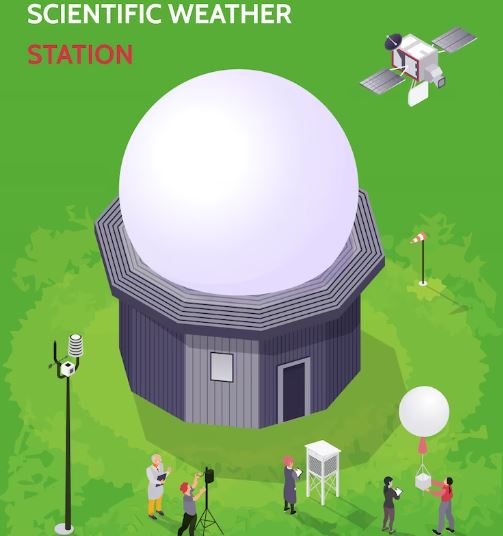
A weather station is a collection of instruments that measure various atmospheric conditions such as temperature, precipitation, wind speed and direction, humidity, and air pressure. These measurements are critical in helping meteorologists create forecasts that can save lives and protect property. Weather stations can be found all over the world, from remote mountaintops to bustling cities.
There are several types of weather stations, each with its own set of instruments and capabilities. Some are designed for personal use, while others are used by professional meteorologists. The type of weather station you choose will depend on your needs and budget.
Types of weather stations
Home weather stations are designed for personal use and are typically small and affordable. They consist of a few key instruments, such as a thermometer, barometer, and anemometer, and can be used to monitor weather conditions in your backyard. Some home weather stations can even be connected to your smartphone or computer, allowing you to track weather patterns in real-time.
Professional weather stations, on the other hand, are much more advanced and are used by meteorologists and other weather professionals. They typically consist of a wide range of instruments, including sensors that measure temperature, humidity, air pressure, wind speed and direction, and precipitation. Professional weather stations are often located in remote areas, such as mountaintops or deserts, to provide accurate measurements of weather conditions.
Components of a weather station
A weather station is typically made up of three key components: sensors, a data logger, and a transmitter. The sensors are the instruments that measure the various atmospheric conditions. These sensors are connected to a data logger, which records the measurements and stores the data. The transmitter then sends the data to a central location, where it can be analyzed and used to create weather forecasts.
The sensors used in a weather station can vary depending on the type of station and the atmospheric conditions being measured. For example, an anemometer is used to measure wind speed and direction, while a barometer is used to measure air pressure. Other sensors may be used to measure humidity, temperature, and precipitation.
How do weather stations work?
Weather stations work by collecting data on various atmospheric conditions and transmitting that data to a central location for analysis. The sensors in a weather station measure conditions such as temperature, humidity, air pressure, wind speed and direction, and precipitation. This data is then recorded by a data logger and transmitted to a central location using a transmitter.
Once the data has been collected, it is analyzed by meteorologists and other weather professionals. This data is used to create weather forecasts, which can help people prepare for severe weather conditions such as hurricanes, tornadoes, and floods.
Importance of weather stations
Weather stations are an important tool in predicting the weather. They provide critical data that is used to create weather forecasts, which can help save lives and protect property. For example, weather forecasts can help people prepare for severe weather conditions such as hurricanes, tornadoes, and floods. By knowing when severe weather is expected, people can take steps to protect themselves and their property.
Weather stations are also used by industries such as agriculture and transportation. Farmers use weather data to plan their crops and irrigation schedules, while transportation companies use weather data to plan routes and schedules.
Applications of weather stations
Weather stations have a wide range of applications, from personal use to professional meteorology. Home weather stations can be used to monitor weather conditions in your backyard, while professional weather stations are used by meteorologists and other weather professionals to create weather forecasts.
Weather stations are also used by industries such as agriculture and transportation. Farmers use weather data to plan their crops and irrigation schedules, while transportation companies use weather data to plan routes and schedules.
Factors to consider when choosing a weather station
When choosing a weather station, there are several factors to consider. One of the most important factors is accuracy. You want to make sure that the weather station you choose provides accurate measurements of atmospheric conditions.
Another factor to consider is the type of sensors used in the weather station. Different sensors are used to measure different atmospheric conditions, so you want to make sure that the weather station you choose has the sensors you need.
Other factors to consider include price, ease of use, and durability. You want to choose a weather station that fits your budget and is easy to use and maintain.
Maintenance and calibration of weather stations
To ensure that your weather station provides accurate measurements of atmospheric conditions, it is important to perform regular maintenance and calibration. This includes cleaning the sensors and data logger, checking the batteries, and recalibrating the sensors as needed.
Calibration is the process of adjusting the sensors to ensure that they provide accurate measurements. This is typically done by comparing the measurements from the weather station to measurements from a reference instrument.
Conclusion
Weather stations are an important tool in predicting the weather. They provide critical data that is used to create weather forecasts, which can help save lives and protect property. There are several types of weather stations, each with its own set of instruments and capabilities. When choosing a weather station, it is important to consider factors such as accuracy, sensor type, price, ease of use, and durability. Regular maintenance and calibration are also important to ensure that your weather station provides accurate measurements of atmospheric conditions.


